 |
Morals
Problems and Solutions regarding
Natural Marriage and Civil Marriage
Fr. Paul Sretenovic
Marriage according to Natural Law has in itself an importance that exceeds what today we understand by “natural.” We are filled with incorrect naturalistic ideas coming from the Enlightenment and influenced by the attacks the so-called natural sciences made against Catholic dogma. This revolutionary Naturalism imagines nature as independent of or even against God.
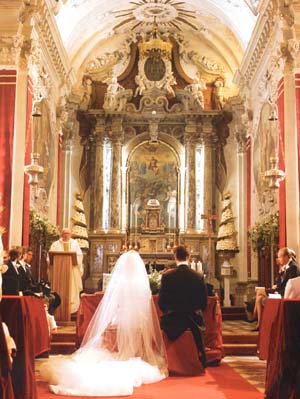
Church marriages in Italy are preceded by a civil ceremony in the local court - Point de Vue, October 26, 2004 |
Natural Law is a different thing. It is the reflection in human nature of Divine Wisdom. In everything He created, God printed eternal principles that reflect Him. In the universe the ensemble of these principles is called Eternal Law; in mankind it is called Natural Law. Natural Law correctly understood raises a profoundly religious sentiment. For this reason, before the coming of Our Lord Jesus Christ, marriage – even among pagans – included many religious rituals. Also because of this, the Catholic Church considers the natural marriage instituted by God in Paradise a pre-figure of the Sacrament of marriage instituted by Jesus Christ.
The end of the marriage according to Natural Law – we saw this in my last article – is the fulfillment of the divine precept “Increase and multiply and fill the earth” (Gen. 1:28). That is to say, at the moment our first parents were put out of Paradise, God was concerned about the good of all mankind. To conserve it, He ordered them to multiply. Therefore, while it is a natural and social institution, marriage is defined as a union of a man and a woman in order to generate and educate offspring to conserve and propagate the human race (Noldin-Schmitt, Summa Theologiae Moralis, part III, book 8, § 502).
If a marriage between non-baptized persons was entered into with this purpose, then Catholic doctrine considers it legitimate (ibid., § 513). This kind of marriage exists today among Jews, Arabs, and pagan peoples. One of the conditions for this marriage to be legitimate is for it to be witnessed by some authority, be it religious or civil. When the Church recognizes these marriages as legitimate she is not saying that those religions are true, because they are not. Nor is she affirming that the civil authority by itself has the full right over marriages, because it does not. She is just acknowledging them as an authority that witnesses and ratifies the contract between the two parties.
Are all those marriages legitimate? No. They have to satisfy some requisites to be such: if a man has many spouses, only the first is legitimate; if the couple does not want to be together for life, it is illegitimate; if they do not want to have children, it is illegitimate, and so on. But my goal here is not to enter into the exceptions. I am only looking at the rule. I want to avoid the simplification that often has been made in certain traditionalist milieus where some priests affirm that any marriage that is not made before a priest is illegitimate. To automatically declare that any Jewish, Muslim, Buddhist, and Hindu unions between a man and woman was never a legitimate marriage seems to me a great misunderstanding and lack of good sense, as well as projecting a bad image of the traditionalist priest. Anyone affirming such a thing does not take into consideration what a marriage according to the Natural Law is.
The role of the civil authority – Historical contours
The last three centuries of relations of the Church and civil authorities regarding Catholic marriage has been a sad chapter. In it one finds the revolutionary plot the civil authority made against Catholic marriage. Let me summarize what happened historically and why it came to pass.
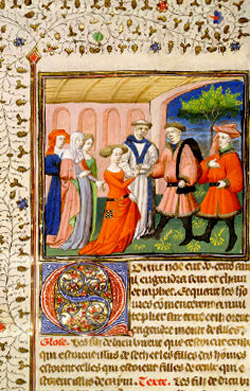
During the Middle Ages the Church marriage as a sacrament was upheld by the State - 14th-century manuscript of Guyard Desmoulins |
Speaking in broad lines, after the establishment of Christendom in Europe in the Middle Ages, the State was open to the good influence of the Catholic Church. This produced juridical consequences for marriage.
On one hand, the State recognized the Catholic marriage as legitimate before civil law. On the other hand, the Church recognized the State as the legitimate authority over civil aspects of marriage: e.g., the contract of the parties regarding temporal goods; the right of the wife and children to share the father’s goods; the dignity and titles to be conferred to the father and mother; the right to legitimately inherit; the amount of the bride’s dowry, etc.
The marriage was simultaneously religious and civil. The ceremony that took place in the church was enough for the couple to be considered married before the State and, therefore, to share the same goods, have legitimate children who would be entitled to receive an inheritance, etc. While this union between Church and State existed, harmony reigned in society and stability in the family.
The first blow against this balanced situation came with Protestantism. Its revolt against the Catholic Church and Papacy, the fact that its ministers became subservient to temporal princes, and the introduction of divorce profoundly disrupted that harmony.
Those factors paved the way for the Enlightenment to frontally attack Catholic marriage. Its sophist two-folded argument was this: Marriage is essentially a natural contract between the two parties; the sacrament conferred by the Church is a dispensable accident. This pernicious thesis was put in practice by the French Revolution. It sustained that the State is the only necessary witness of this contract. From this came the separation between the religious and civil marriage. It went even further: the State only recognized the civil marriage in matters pertaining to civil laws. This represented the complete laicization of marriage. Based on the Declaration of the Rights of Man, the French Revolution also decreed that marriage is a pact that depends on the free and sovereign will of a man and a woman and, therefore, can cease should the parties so desire. With this, divorce was introduced into civil law.
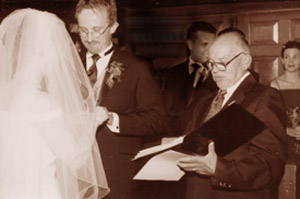
Above, a justice of the peace in Massachusetts performs a civil marriage. Below, instant civil weddings are available from the Chapel of Love in California.
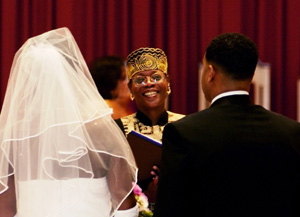 |
In parallel, the State abolished the superiority of the Catholic Church before civil law. All religions are equal before the law – says the indifferentist democratic aphorism – and therefore the Catholic marriage should be on the same level as the Protestant, Jewish, Hindu, or any other marriage.
Doing this, the State frontally rejected Catholic marriage. It completely denied the Sacrament its temporal rights and decreed that only civil marriage was valid. The wise previous order was set up-side-down.
Such ideas spread all over Europe and, with the help of Masonic lodges and other agents of the Revolution, were implanted in almost all legislations of the Modern States. This includes the United States.
What happens here is, before the couple is married in the Catholic Church, the priest receives a civil license to marry a couple as a representative of the State. After the religious wedding in the Church, the documentation with the signatures of the witnesses is sent to the city council, so that the marriage can be registered in the civil records. This was what I experienced in my two and a half years as a priest in New Jersey.
That is to say, it appears that the State is recognizing the Catholic marriage, but the reality is different. The priest – or Protestant minister or Jewish rabbi - is entitled by the State to act as its representative and receive in the name of the State the signature of the couple. Therefore, in reality there is not just one ceremony, but two, one before the representative of the lay State, and the second before the Catholic Church. The confusion is that the priest plays both the role of representative of the Church and representative of the revolutionary State. It is a contradictory situation.
I think that it would be better if things were expressed in a less hypocritical way, as they are in European and South American countries where there are two different marriages in two different places,one civil and another religious. At least then persons would not have the notion that the Church has more liberties and rights than she actually has.
In the 19th century, the Church made a counter-attack on this usurpation of the State, stressing the doctrine of the Catholic marriage as essentially a contract-sacrament having full civil rights.
Characteristics of Catholic teaching
Let me give an example to make the topic less theoretical. Many authors sustain, and I agree with them, that Our Lord instituted marriage at the wedding of Canaan. So, I will take my example from there.
At Canaan, Jesus Christ transformed the water into wine. It is a good metaphor for what happened with marriage. It was water in the Natural Law stage, and it became wine when it became a Sacrament. To transform the water into wine was an enormous improvement that was worked by a miracle. Once it became wine, no one else can come and re-transform it into water. It is impossible. So it is with the Sacrament of Matrimony. Once the natural marriage became a Sacrament, no one else can reduce it to a simple natural contract.
It is still a natural contract for persons who did not receive Catholic Baptism, and the Church recognizes those contracts. But to persons who are or were Catholics, it is impossible to reverse the marriage from a Sacrament to just a natural contract.
This example – the water transformed into wine that cannot be reversed – explains the great apostasy of the nations that once were part of Christendom but stopped recognizing the civil consequences of the Sacrament. Instead they imposed civil marriage as the sole cause of the civil rights of the parties. It also explains the teaching of the Catholic Church from the 18th century up until Vatican II regarding marriage. She radically opposed this conception of civil marriage because she knew that it was a maneuver to usurp her rights over the nations that in days past formed Christendom.
No human law can go against Divine Law. What is the Divine Law? What should we think about human laws?
Divine Law is the ensemble of precepts revealed by God to men, that is, the Decalogue and the precept of charity of the Gospel that completed it (Mark 12:31; John 4:20).
Positive law is the law made by man to rule human society. Positive law must be according to Natural Law and Divine Law. If it is not, it is illegitimate.
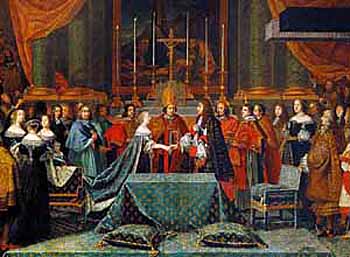
The Church was the authority on marriages in Catholic States, even the marriages of Kings. Above, the marriage of Louis XIV and Marie Therese of Austria. Van der Meulen |
Regarding marriage, the laws of the French Revolution and, by extension, of the Modern State born from it, are laws against Divine Law. They deny the rights of God and the Catholic Church in society.
The Catholic teaching on this topic of marriage is extraordinarily consistent regarding the rights of the Church and the usurpation made by the Modern State. Pope Pius IX anathematized the basic doctrine of the Enlightenment in seven condemned propositions of the Syllabus (65th to 71st). I reproduced here only the 66th proposition:
“66. The Sacrament of Marriage is only something accessory to the contract and separate from it, and the Sacrament consists in the nuptial blessing alone.”
Leo XIII wrote many documents condemning the same error, the most important of them being his Encyclical Arcanum Divinae Sapientiae. In it he strongly condemned the agents of the Revolution, those persons who “thanklessly casting away the many blessings of the Redemption, despise or utterly ignore the restoration made and the perfection introduced in marriage” (§ 10).
He also analyzed the cause of that revolt, that is, the Enlightenment. He wrote: “The chief reason why they act in this way is because many persons, imbued with the maxims of a false philosophy and corrupted by vicious habits, judge nothing so unbearable as submission and obedience. They strive with all their might to lead individuals, families, and all human society itself to proudly despise the sovereignty of God.” (ibid.).
Then, the Pontiff summarized the contention: “Now, since marriage is the principle and origin of the family and human society, these men cannot bear that it be submitted to the jurisdiction of the Church. They go further in their bad will, and endeavor to deprive it of its holy character and reduce it to the lesser sphere of the human institutions, which are ruled and administered by the civil law of the people.
“Hence, they attribute all power over marriage to civil rulers, and deny the Church any right. They say that if the Church ever exerted any such power, she acted either by the indulgent favor of the princes or by usurpation. …
“Finally, we see that all power in prescribing and passing judgment in this subject [of marriages] has been so skillfully taken from the Catholic Church, so that no regard is paid either to her divine power or to her wise laws. Yet under these, for so many centuries, the nations lived – those nations on whom the light of civilization shone bright with the wisdom of Christ Jesus” (ibid.).
That is to say, he clearly condemned those who imposed the civil marriage of the Modern State in opposition to the Catholic marriage.
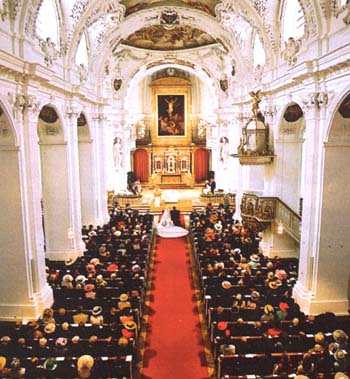
A marriage in a Catholic Church in Bavaria - Point de Vue, Oct. 5, 2005 |
This militant position of the Church remained the same until Vatican II. It remained the same but there were some nuances worthy of mention. The same doctrine continued to be defended in theory, but a different policy was adopted in practice. That is, in face of the almost unanimous acceptance of the Modern Sate in the countries that once composed Christendom, the Church adopted a modus vivendi [a way to live] with the Modern State. She set aside the fight for a restoration of the Catholic State as well as her rights regarding Catholic marriage. The Church agreed to coexist with the Modern State, closing her eyes to the fact that Catholics had to “marry” again before the civil authority in order to have their civil rights recognized.
Was it wrong for the Church to have accepted this coexistence? I wonder if a more combative position would not have brought more fruits for the Catholic cause than this peaceful coexistence that gave the impression of tacit approval. But, we cannot undo the past; we have to face the facts as they are.
There are two ways to face this coexistence. One is a liberal approval of civil marriage and a de facto renunciation of the rights of the Catholic marriage. It is the progressivist position. This was basically what Vatican II did with its aggiornamento, its adaptation to the modern world.
Another is a position of sorrow for what was lost with the resolution to make continuous prayer and action to restore Catholic marriage. The final aim is not just to restore Catholic marriage, but to convert the revolutionary Modern State, just as in the past the Church converted the pagan Roman Empire and the Arian Germanic tribes.
This is a work that demands strength and patience. It also demands an intelligent and habitual position of resistance against the error of the Modern State. Today we may be obliged to obey its directives, as Catholics did under the Roman Empire, but our final aim is to reach a better end in the future.

Posted October 19, 2005

Related Topics of Interest
 A Refresher on Catholic Teaching about
Marriage A Refresher on Catholic Teaching about
Marriage
 The Lesson of Lourdes on Suffering The Lesson of Lourdes on Suffering
 How to Address Priests and Religious How to Address Priests and Religious
 Ratzinger on Feminism Ratzinger on Feminism

|
Morals | Religious | Home | Books | CDs | Search | Contact Us

© 2002-
Tradition in Action, Inc. All Rights Reserved
|
 |
|